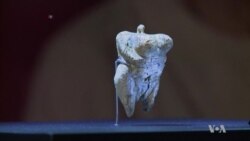ໃນພາກຕາເວັນຕົກສຽງໃຕ້ຂອງປະເທດ ເຢຍຣະມັນ, ສາຍພູຕ່າງໆມີແມ່ນໍ້າໃຕ້ດິນໄຫຼ
ສັບສົນໄປມາຫຼາຍສາຍ ເຮັດໃຫ້ບໍລິເວັນດັ່ງກ່າວຖືກພັດເຊາະເປັນຖໍ້າຫີນປູນບູຮານ. ຂົງເຂດນີ້ແມ່ນອຸດົມສົມບູນໄປດ້ວຍປະຫວັດສາດມະນຸດ ແລະ ອົງການ ການສຶກສາ, ວິທະຍາສາດ ແລະ ວັດທະນະທຳຂອງອົງການສະຫະປະຊາຊາດ ຫຼື UNESCO ກຳ
ລັງພິຈາລະນາຢູ່ວ່າຈະປະກາດຖໍ້າດັ່ງກ່າວ ໃຫ້ເປັນສະຖານທີ່ມໍລະດົກໂລກ. ນັກຂ່າວ
ວີໂອເອ Kevin Enoch ມີລາຍງານ, ເຊິ່ງ ພຸດທະສອນ ຈະນຳລາຍລະອຽດມາສະເໜີ
ທ່ານ.
ນີ້ແມ່ນຊິ້ນສ່ວນສິນລະປະທີ່ເກົ່າແກ່ທີ່ສຸດ ທີ່ເຄີຍຜະລິດຂຶ້ນມາໂດຍມະນຸດ. ມັນມີອາຍຸ
ໄດ້ 40,000 ປີ.
ທ່ານ Nicholas Conrad ຈາກມະຫາວິທະຍາໄລ Tuebingen ກ່າວວ່າ “ຄືວ່າ, ມັນມີ
ຖໍ້າ 6 ແຫ່ງໃນສອງຮ່ອມພູຕ່າງກັນ, ເຊິ່ງແມ່ນ ຮ່ອມພູ Lone ແລະ ຮ່ອມພູ Ach, ແລະ ຖໍ້າພວກນີ້ມີຄວາມສຳຄັນຫຼາຍ ເພາະວ່າມັນຜະລິດວັດຖຸສິລະປະຢ່າງຫຼວງຫຼາຍ, ອຸ
ດົມສົມບູນ ແລະ ເກົ່າແກ່ທີ່ສຸດ ທັງມີເຄື່ອງຫຼິ້ນດົນຕີອີກດ້ວຍ, ພ້ອມກັບສິ່ງນະວັດຕະ
ກຳໃໝ່ອື່ນໆ ທີ່ເປັນພາກສ່ວນຂອງການພັດທະນາວັດທະນະທຳໃນເວລານັ້ນ ເມື່ອ
ມະນຸດຍຸກໃໝ່ໄດ້ແຈກຢາຍໄປທົ່ວ ຢູໂຣບ ແລະ ມະນຸດຍຸກຫີນໄດ້ສູນພັນ.”
ກຸ່ມນັກຮຽນຈຳນວນຫຼາຍໄດ້ໄປຢ້ຽມຢາມຂົງເຂດດັ່ງກ່າວເປັນປົກກະຕິ, ເພື່ອເບິ່ງວັດຖຸ
ຕ່າງໆທີ່ມະນຸດໄດ້ສ້າງຂຶ້ນຢູ່ທີ່ນັ້ນ ເພື່ອເປັນຕົວແທນໃຫ້ໂລກທີ່ຢູ່ອ້ອມຂ້າງພວກເຂົາ
ເຈົ້າ.
ທ່ານ Nicholas Conrad ກ່າວວ່າ “ມັນເປັນວັດຖຸທີ່ຖືກເຮັດຂຶ້ນມາດ້ວຍຄວາມສວຍ
ງາມເປັນພິເສດ ຕັດດ້ວຍອຸປະກອນທີ່ເປັນຫີນ ແລະ ເຮັດຈາກງາຂອງຊ້າງແມມ
ມັອດ, ມ້າ ແລະ ຊ້າງແມມມັອດທີ່ມີຊື່ສຽງຈາກຖໍ້າ Vogelherd ຫຼື ຮູບປັ້ນແມ່ຍິງຢູ່
ທາງຫຼັງຂ້າພະເຈົ້າ. ທັງໝົດນີ້ແມ່ນຕົວຢ່າງທີ່ມີອາຍຸປະມານ 40,000 ປີ ທັງເປັນ
ຕົວຢ່າງຂອງສິນລະປະຮູບປັ້ນທີ່ເກົ່າແກ່ທີ່ສຸດ ທີ່ເຄີຍຮູ້ຈັກຈາກບ່ອນອື່ນໆຢູ່ໃນ
ໂລກ.”
ບັນດານັກຄົ້ນຄວ້າກ່າວວ່າ ມັນມີຄວາມສຳຄັນທີ່ຈະເຂົ້າໃຈວ່າ ເຖິງແມ່ນວ່າມະນຸດຜູ້ທີ່
ໄດ້ອາໄສຢູ່ທີ່ນີ້ເບິ່ງຄືຈະຄືລ້າຫຼັງ ໃນແງ່ເທັກໂນໂລຈີກໍຕາມ ແຕ່ພວກເຂົາເຈົ້າກໍເປັນ
ມະນຸດທີ່ທັນສະໄໝຫຼາຍ.
ທ່ານ Nicholas Conrad ກ່າວວ່າ “ແລະ ດັ່ງນັ້ນຂ້າພະເຈົ້າຈຶ່ງຄິດວ່າ ມັນມີຄວາມສຳ
ຄັນທີ່ຈະເນັ້ນຢໍ້າວ່າ ຊີວິດແມ່ນມີຄວາມແຕກຕ່າງກັນ ໃນເລື່ອງທີ່ຄົນເຮົາໃຊ້ເຄື່ອງມື
ຕ່າງກັນ, ຄົນເຮົາໄດ້ເຮັດໄດ້ສ້າງສິ່ງທີ່ແຕກຕ່າງກັນ. ແຕ່ພວກເຮົາກໍສາມາດແນ່ໃຈໄດ້
ວ່າ ເມື່ອ 40,000 ປີທີ່ຜ່ານມາ, ໃນພາກສ່ວນນີ້ຂອງໂລກ ໃນພາກພື້ນດ້ານເທິງຂອງ
ແມ່ນໍ້າ Danube ນີ້, ປະຊາຊົນຈຳພວກດັ່ງກ່າວແມ່ນສະຫຼາດ ແລະ ມີຄວາມສ້າງສັນ
ຄືກັນກັບພວກເຮົາດຽວນີ້.”
ອາຍຸຂອງສິນລະປະກຳ, ແລະ ສິ່ງທີ່ສະແດງໃຫ້ເຫັນເຖິງຄວາມປະພຶດຂອງມະນຸດດຶກ
ດຳບັນທັງຫຼາຍ ແມ່ນເປັນສາເຫດທີ່ພາໃຫ້ ອົງການສະຫະປະຊາຊາດ ກຳລັງພິຈາລະ
ນາຢູ່ວ່າຈະປະກາດໃຫ້ພາກພື້ນດັ່ງກ່າວ ເປັນໜຶ່ງໃນສະຖານທີ່ມໍລະດົກໂລກແຫ່ງທີ່
ໃໝ່ທີ່ສຸດຂອງພວກເຂົາເຈົ້າ.
ອົງການ UNESCO ຕອນນີ້ ກຳລັງທຳການປະຊຸມກັນຢູ່ໃນປະເທດ ໂປແລນ ແລະ ຈະປະກາດສະຖານທີ່ໃໝ່ທຸກໆແຫ່ງໃຫ້ຊາບໃນປີນີ້.
((INTRO))
[[In the southwestern part of Germany, the mountain ranges are crisscrossed with subterranean rivers that have left the area honeycombed with ancient limestone caves.This area is rich in human history and the United Nations Educational, Scientific and Cultural Organization, or UNESCO, is considering declaring the caves a World Heritage Site.VOA's Kevin Enochs reports.]]
((NARRATOR))
These are some of the oldest pieces of art ever produced by humans.They are 40,000 years old.
((NICHOLAS CONRAD, UNIVERSITY OF TUEBINGEN))
"Well, there are six caves in two different valleys, the Lone Valley and the Ach Valley, and these caves are important because they produce the most abundant, richest and oldest record of early art works and also musical instruments, along with a whole range of other innovations that are part of the cultural development of the time when modern humans spread across Europe and Neanderthals go extinct. "
((NARRATOR))
School groups visit the area routinely, to see the objects that humans created there to represent the world around them.
((NICHOLAS CONRAD, UNIVERSITY OF TUEBINGEN))"And they are typically beautifully formed objects cut with stone tools and made from mammoth ivory - the famous horse and mammoth from Vogelherd or the female figure behind me.These are all examples that date to about 40,000 years old and are the oldest examples of figurative art known anywhere in the world."
((NARRATOR))
Researchers say it is important to understand that even though the humans who lived here seem primitive in terms of technology, they were very much modern humans.
((NICHOLAS CONRAD, UNIVERSITY OF TUEBINGEN))
"And so I think it is important to stress life was different in the sense that people used different tools, people did different things.But we can be sure 40,000 years ago, in this part of the world in the upper regions of the Danube, the people were just as smart and creative as we are."
((NARRATOR))
The age of the artifacts, and the window into early human behavior is why the United Nations is considering declaring the region one of its newest World Heritage Sites.
UNESCO is meeting now in Poland and will announce any new sites this year.










